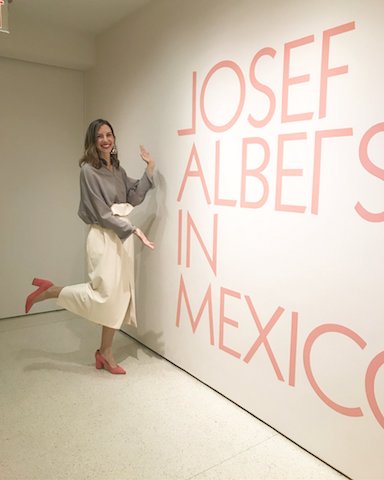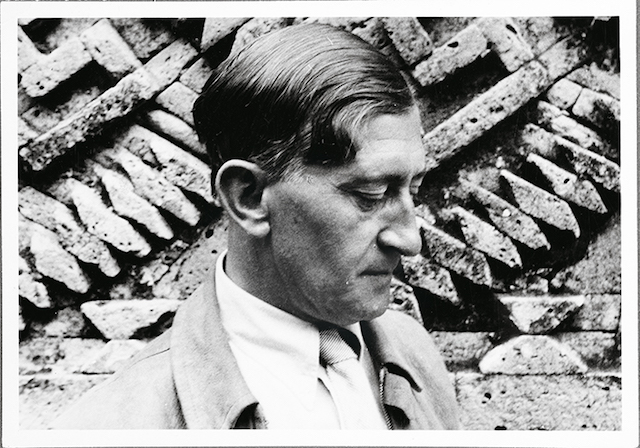
Photo of Lauren Hinkson.
The Heard Museum’s newest exhibition, the “Josef Albers in Mexico” show, is an ode to the vibrant and brightly-colored abstract works of Mr. Albers, himself. Though Albers was a masterful artist, most notably known for his unique perceptions of art and the charismatic pieces that he created, he also inherited a unique appreciation for the world in which he lived in and traveled. The show provides an insight into the unparalleled mind of one of the world’s greatest abstract artists and offers a unique perspective on the country of Mexico – as seen through Albers’ creative lenses, of course.
The heart of this exhibition, though, is found in Lauren Hinkson – the Associate Curator of Collections at the Guggenheim – who has served as an advocate for the show since its inception. The exhibition was born at the Guggenheim Museum in New York and has now found another short-term home at the Heard Museum. We had the opportunity to talk with Hinkson about the power of art, the work that went into bringing this remarkable show to life, and how she’s using her position to bring attention to the hidden works and legacies of lesser-known artists.
AFM: So, for our readership who might not know much about Josef Albers or about his exhibit [Josef Albers in Mexico] at the Heard Museum, can you give a little bit of background about the show and the significance of it?
LH: Sure. So, this is the exhibition’s third stop in a tour. The exhibition originated at the Guggenheim in New York, where I presented it at our museum here. And then it traveled to Venice. And the final stop is the Heard Museum in Phoenix. We thought it would be a great exhibition for audiences in Phoenix who kind of know modern art, those who may have traveled to Mexico or who maybe have never even heard of Josef Albers – they’ll all be able to learn more through the exhibition in a very unique way, both through the photographs and paintings. There’s some brightly colored landscapes – it’s just a really multifaceted exhibition. So, there’s a lot of different ways to engage with the material in view. So, the exhibition is of course looking at the modern master Josef Albers, whose kind of one of the twentieth centuries most important thinkers. And what we’re showing in this exhibition is about one hundred works – which are comprised of about 30 paintings and the rest of the work is photo collages and works of papers. Everything in the exhibition was made between the 1930’s and the 1970’s, and reflects Josef Albers’ interest in Mexico.
So, what we’re seeing in this show is the influence of Albers’ encounters with pre-Columbian monuments on his travels to Mexico. He and his wife, Annie Albers, took a car trip – that took many, many days and sometimes weeks [laughs] – from North Carolina, where they were both teaching at Black Mountain College. They then went down to Mexico. When they first got to Mexico, they wanted to see the ruins throughout the country. They took over a dozen trips between the 1930’s and the 1960’s. Josef photographed sites likes Teotihuacan and so many more. He went to all of these different sites, took photos of the ruins and essentially collaged these pictures together and made these little works of art, that really developed into abstract art pieces. The exhibition really proposes this relationship between his encounters in Mexico and what we come to know Josef Albers for later on in the 50’s and 60’s through his adobe paintings. So, it’s kind of a revision of the origin story of his ideas about abstract art and kind of placing it in Mexico.
AFM: As you mentioned, this is the exhibition’s third stop in the tour. How excited are you to showcase this exhibit to Phoenix audiences at the Heard Museum?
LH: We’re so excited about having it at the Heard, specifically, because it really illuminates the kind of influence of indigenous cultures on art, and of course, that’s the Heard’s mission. In their case, they’re representing Native American art, but any indigenous cultures of their America’s had a profound influence on modern art. So, this is kind of an opportunity to look at that and unpack it a little bit in the context of this important artist. It’s really exciting because in New York, we live in a very different landscape compared to Phoenix. With that, there’s a real connection to place in the show and especially to ideas of color and light and the landscape. You can feel all of that when you’re in Phoenix, because you can see the horizon line and you have this incredible light in Phoenix – and it’s something that you can really feel in the work. So, I think that’s a very powerful, kind of resonating experience for visitors to the show. There’s this great idea of intersectionality that the director is trying to put forth, so we’re really excited to have it at the Heard Museum.

Photo of Josef Albers.
AFM: Art really has the ability to break down barriers and shed a light on different cultures. For you, being the Associate Curator at the Guggenheim, how important do you think this type of exhibit is for people to see, particularly now given the current climate within our country?
LH: The incredible thing about art is that it has the power to unify. I do think that the resonances [within this exhibit] are really meaningful. There are so many different ways to approach the material and also the place that’s represented. I think what I’ve witnessed, and also what I’ve seen since the show has opened in Phoenix and New York, our immigrant communities who came to the exhibition and responded to it, was that for many people, it’s home. It has had a very personal resonance with those communities and then also with other communities who are viewing it from a travel or tourism perspective, have gone to these sites and have therefore walked away with a different meaning and a different personal connection. Josef Albers was a German immigrant to the United States, so that carries a very powerful message within the story, too. But, I think what’s important to remember in the exhibition is that these artists [Josef and Annie Albers] were traveling to Mexico in the 1930’s, when there really wasn’t a tourism industry yet. They were not explorers, but they were curious tourists who became a part of some artistic communities while they were traveling through Mexico, and there was an exchange of ideas that took place. The power in art – as I said before – to unify and to create a space for conversation and dialogue is something that I think is apparent in any exhibition today of modern or contemporary art. I hope that people will come to the show and bring their own kind of perspectives, resonances and stories, and will then share them with one another during the course of the show. Josef certainly was an artist and educator who believed in the kind of generosity of art and possibility to speak to people in many different ways. He made work that allowed for that.
AFM: And Lauren, working for a place like the Guggenheim, I know that you’ve probably seen dozens and dozens of collections and exhibitions. What would you say to convince people to pay a visit to this exhibition in particular? What makes it unique or different from other exhibits and collections that focus on indigenous people and the vibrancy of their cultures?
LH: Well, what I would say is that the audiences in Phoenix should come and see this show because it’s the first time that Josef Albers has had an exhibition in Arizona. So, I think for many people, this will be the first time that they’ve seen this work in a significant way. One hundred works is a lot and it’s the first time that this much work – especially from this time period – was shown anywhere in the United States. Many of these works were not known during his lifetime and have therefore never been shown before. So, there are so few paintings in particular that have not been viewed by the public since the 1940’s. It’s a real opportunity for a new generation of viewers to get to know Josef Albers and they may not have another chance, so they should go see this show. It’s not just about greatest hits; there’s a lot of scholarship and there’s great publication available, as well. But, I would also note that there are so many different entry points to this exhibition. It’s not just about abstract painting, it’s also about photography. So, you can look at it from the perspective of architecture, from the perspective of travel, from abstract painting, from color. So, there’s a lot of different ways for audiences of all ages to engage with the show.
AFM: As a fan of art yourself, are you drawn to certain collections? Or do you have a sort of theme for exhibitions that you try to bring to life for audiences as an associate curator?
LH: So, I am a collections curator here [at the Guggenheim], so I focus on permanent collection holdings. I’ve always had an interest in unearthing the kind of gems of collections that are overlooked, for one reason or another, and bringing them to life so that scholars, students and also the general public, has the opportunity to see these works. For this show, our photo collages had never been exhibited. So, I found them in our storage facility and was so excited and interested by these images from the 1930’s, because you can actually see that some of the archeological sites are being excavated in the photos. If you look at one site from the 1930’s to the 1950’s, their unearthing new discoveries. To me, that kind of idea of discovery both in the show and in my own practice, is something that has always drawn me back to the Guggenheim’s collection, and also kind of trying to reframe the great masters of art history and looking at artists or practitioners who have – historically – been overlooked, whether that be because they are a woman or because they were working outside of the main ideas of recognized artistic production. That has always been my area of interest, but generally, I work in all medians and time periods.
Josef Albers in Mexico is in display at The Heard Museum through May 27.